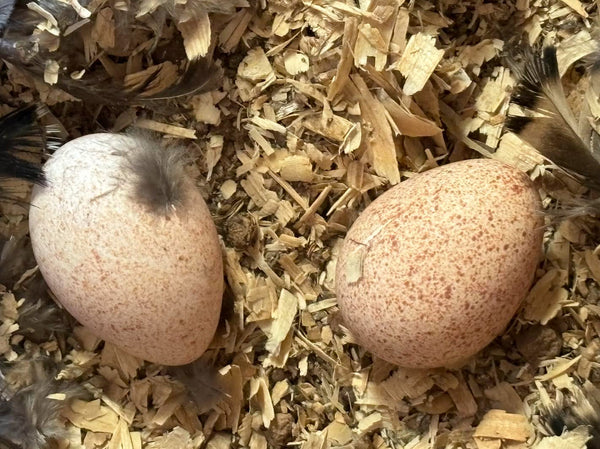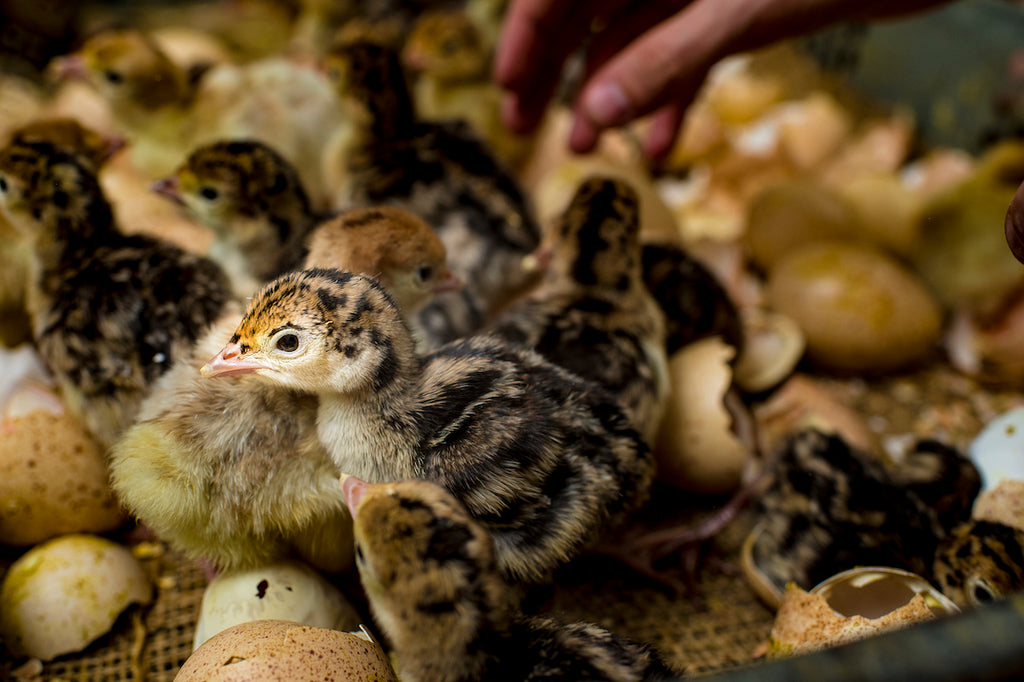
Eggs and Hatching!
March and April and May are when Thanksgiving starts if you are a turkey farmer. Even with all the scientific advancements made by humankind, there is still only one way to produce a turkey poult for Thanksgiving and that is through a hen laying an egg. Once the egg comes out, we have learned how to replicate what the mother would do in nature, but the beginning of the cycle has always been the same. Follow along with us, step-by-step, as we explore this fascinating process!
When a hen is about to lay eggs, she will make an indent or hole in the dirt (in nature) or in her crate (on the farm) to give her eggs access to extra moisture. A hen in the wild will gather the material needed to fill a nest but Frank Reese provides nesting material at Good Shepherd Ranch so she does not have to hunt for it. Soon after, the first egg will be laid. But that is not the only egg in the hen. But that is not the only egg she will lay. The hen actually has a clutch of eggs from a single mating with a tom — usually 12-18 total!

She will usually lay 12-18 eggs over a period of about 21-28 days. After 14 days, eggs start to lose fertility on the farm but not in the wild. Frank has no idea why this is the case and believes nature is always the best at doing things. During the egg laying period, the hen will exercise, explore, eat, and drink, but she will always return to her eggs. Before leaving them, she will cover the eggs with whatever material she can find to protect them from predators and from temperature fluctuations since she won’t be there to keep them warm.
None of the eggs have started the incubation process until all the eggs in the clutch have been laid. In the meantime, they lie dormant, ensuring all the eggs start the process of growing together, so that they will all hatch at the same time. Hatching at once is crucial for survival in the wild — once the poults come out of the egg, the birds must be ready to run away from the nest before varmints sniff them out.
The mother triggers the incubation process by increasing her own body temperature over the next 28 days. During this period, she will almost never leave her babies. The temperature she seems to instinctively understand to be the magic number is 99.5 degrees, the very same temperature that every incubator is set to at every turkey farm around the world. If it’s hot outside the hen will stand up over the eggs so they cool down. If it’s cold, she will move the eggs closer to her body. 99.5 degrees is always maintained. Four out of 18 eggs will make it to adulthood in the wild. Frank expects a survival rate of 90% on the farm.
During incubation the hen rocks the eggs from side-to-side using her beak or feet so that the embryos move around and do not stick to the side of the shell. This is the very motion artificial incubators imitate. Frank’s incubators turn the eggs every 2 hours while fans keep the incubation room fresh with air movement, holding the eggs at 99.5 degrees and 55% humidity.
On the 26th day the poult will peck a single hole into the round part at the top of the egg. The beak is sharp at the tip allowing the baby to break through to the surface. Over the next two days poults will increase the size of the hole eventually making a perfect incision all around the top of the egg. During this process oxygen enters the yolk for the first time helping the poult acclimate to the outside. Poults do not crack any other part of the shell or yolk because they need to absorb every bit of nutrients from the yolk through their umbilical cord.
At this point, before the hatch, the poults start making voice sounds that the mother hen hears and responds to, and they talk back and forth. Voice recognition is how turkeys find their mothers and communicate in the wild, or on the farm. For instance, if a predator flies overhead the poult instinct is to drop and remain still, even for hours on end. They will stay in their spot motionless until the mother calls for them to come out. Frank’s birds also demonstrate these instincts even though they are domesticated.
Starting on the 26th day Frank looks into the incubator for holes in the top of the eggs and listens for sounds. The eggs are then moved to the hatcher. Within 24-48 hours, the poult will have completely removed the top of the egg off. On the 28th day the poults are born and ready to run and explore their surroundings. As Frank says, “they are out of there.”

With no help from their mother, or the farmer, turkey poults dry themselves within hours so that their feathers fluff up. Poults must figure out how to eat and drink on their own as soon as they leave the nest — the hen will not bring them food and regurgitate it as other birds do — and luckily for them they are good imitators. The poult will imitate every behavior of their mother for eating, drinking, and picking grass. Little turkeys are born with flight feathers and ideally for survival in the wild they should be in the trees within 5-6 days. One thing the mother does is keep the young ones warm — once out, wild turkeys will call out to mother if they are too cold and she will sit back on them to regulate their internal temperature.
For domesticated turkeys the goal is for the poults to be out of the hatcher trays when they are dry so they can be moved to the brooder barn where they have access to water, usually within hours. The brooder is an artificial way of taking care of the babies the way the mother would, including feeding, heating, and giving them access to light as poults do not eat in the dark. In the brooder the heat is in the middle of the room, the water at the edges, and there are no corners — it is built in a circular shape — because when scared baby poults can pile onto each other in a stampede.
Over the next few months the poults will continue to grow, eventually being allowed to roam outside. Come November, a selection will be made and breeders are held back and the others are processed to adorn our Thanksgiving tables. But it all starts with the egg!

